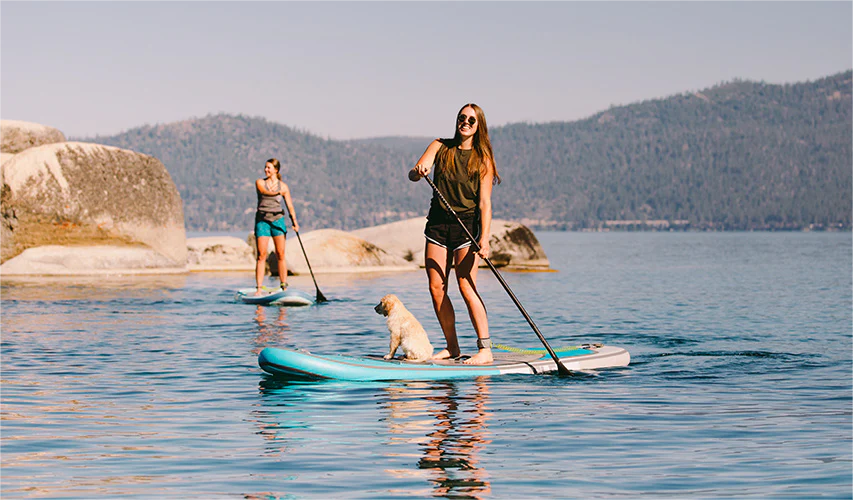Paddleboarding has surged in popularity as a recreational activity, providing individuals with a unique way to explore the waters while engaging in a full-body workout. Central to the experience of paddleboarding is mastering the technique of using the paddle efficiently. While it may seem straightforward, proper paddle technique can significantly enhance your performance, reduce fatigue, and prevent injury. In this comprehensive guide, we delve into the intricacies of paddle board paddle technique, exploring different approaches and offering insights to help you optimize your paddleboarding experience.
Understanding Paddle Board Paddle Anatomy
Before diving into paddle techniques, it’s essential to familiarize yourself with the anatomy of a paddle board paddle. Understanding the different parts will not only aid in comprehension but also in executing the techniques effectively.
1. Blade: The blade is the wide, flat portion of the paddle that propels you through the water.
Shaft: The shaft is the long, cylindrical part of the paddle that you hold onto.
2. Handle: The handle is the grip at the top of the shaft where you place your hands.
3. Blade Angle: The angle of the blade relative to the shaft can vary and affects how the paddle moves through the water.
Choosing the Right Paddle
Selecting the appropriate paddle is crucial for optimizing your paddleboarding experience. Several factors influence the choice of paddle, including your height, paddling style, and intended use. Here are some key considerations:
1. Length: The length of the paddle should be determined by your height and the type of paddling you’ll be doing. A general rule of thumb is to choose a paddle that is 8-10 inches taller than you for flatwater paddling and 6-8 inches taller for surfing or racing.
2. Material: Paddle board paddles are typically made from materials such as aluminum, fiberglass, carbon fiber, or wood. Carbon fiber paddles are lightweight and provide excellent performance but tend to be more expensive.
3. Blade Size and Shape: The size and shape of the blade can affect how the paddle moves through the water. Larger blades are suitable for powerful strokes, while smaller blades are better for quick maneuvers.
Basic Paddle Board Paddle Techniques
Now that you have the right paddle, let’s delve into some fundamental paddle techniques to get you started on the water:
1. Proper Grip: Hold the paddle with both hands shoulder-width apart, keeping your elbows slightly bent. Your top hand should grip the handle, while your bottom hand should grip the shaft. Ensure that the blade is oriented correctly, with the concave side facing forward.
2. Forward Stroke: The forward stroke is the most basic paddle stroke and is used to propel the board forward. To execute this stroke, immerse the blade fully into the water near the nose of the board, then pull it back alongside the board towards your feet, rotating your torso as you paddle.
3. Backward Stroke: The backward stroke is used to reverse the direction of the board or slow down. To perform this stroke, place the blade in the water near the tail of the board and push it away from you, again rotating your torso for added power.
4. Sweep Stroke: The sweep stroke is a turning stroke used to change the direction of the board. Start by placing the blade in the water near the nose of the board, then sweep it outwards in a wide arc, keeping the blade angled towards the direction you want to turn.
Advanced Paddle Board Paddle Techniques
Once you’ve mastered the basic techniques, you can explore more advanced paddle strokes to improve your efficiency and maneuverability on the water:
1. High Brace Stroke: The high brace stroke is used to maintain balance and stability when paddling in rough or choppy conditions. To perform this stroke, raise the paddle above your head with your arms fully extended, then push down on the water to stabilize yourself.
2. Low Brace Stroke: The low brace stroke is similar to the high brace but is performed with the paddle closer to the water’s surface. This stroke is useful for maintaining balance when making quick turns or maneuvering through obstacles.
3. Draw Stroke: The draw stroke is used to pull the board sideways through the water. To execute this stroke, place the blade in the water parallel to the side of the board, then pull it towards you while keeping the paddle close to the board’s surface.
4. Cross Bow Stroke: The cross bow stroke is a more advanced turning stroke that involves reaching the paddle across the front of the board to initiate a turn. Start by placing the blade in the water on the opposite side of the direction you want to turn, then sweep it across the front of the board in a smooth arc.
Conclusion
Mastering paddle board paddle technique is essential for maximizing your enjoyment and performance on the water. By understanding the fundamentals of paddle technique and practicing regularly, you can enhance your efficiency, agility, and overall paddling experience. Whether you’re a novice or an experienced paddler, continually refining your paddle skills will unlock new possibilities and adventures on the water. So grab your paddle, hit the water, and let the journey begin!

